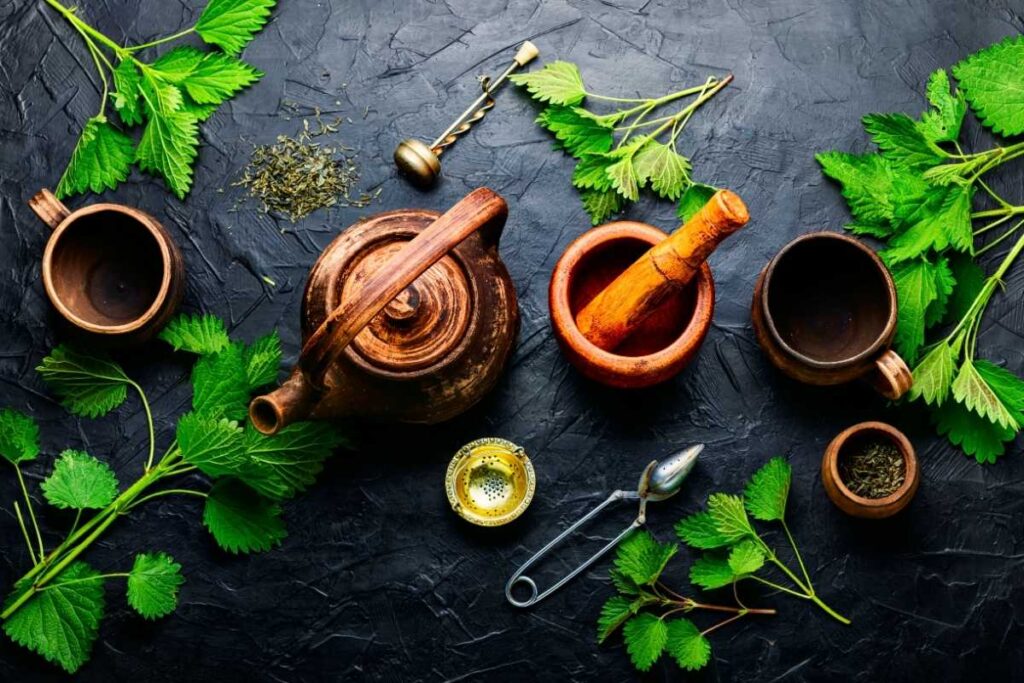Tea Plant 101: The Ultimate Camellia Sinensis Guide

Looking for a popular beverage that can help you relax and energize at the same time? Look no further than Camellia Sinensis, the tea plant. This broad leaf evergreen shrub is native to China and Southeast Asia and is used to make various types of tea, including white tea, Chinese tea, and Erh tea. With its natural source of caffeine and documented in the ancient Chinese book Cha Jing, Camellia Sinensis is a perfect choice for those seeking a refreshing and invigorating drink.
Camellia Sinensis, also known as the tea tree or tea plant, is the only plant used to produce tea commercially in China. The caffeine content in its broad leaves or small leaves varies depending on the type of Chinese tea and how it’s processed. In fact, Lu Yu wrote about this fascinating Chinese plant in his book Cha Jing during the Tang dynasty.
So why not try some camellia sinensis today? Whether you’re looking for a relaxing cup of herbal tea or an energizing boost from your morning cuppa, camellia sinensis, also known as Chinese tea, has got you covered. This popular beverage originated in China and is rich in caffeine, making it a great choice for those who need an extra pick–me-up. In fact, the Cha Jing, a famous Chinese book on tea, praises the many benefits of camellia sinensis. So why not explore the world of Chinese tea and discover its many delights?
Origins and History of Camellia Sinensis Cultivation
You might be surprised to learn that your favorite cup of tea has a rich history dating back thousands of years in China. The scientific name for the tea plant is Camellia Sinensis, a Chinese broad leaf evergreen shrub that grows in warm and humid climates. Interestingly, Camellia Sinensis contains caffeine, a natural stimulant. In this section, we will explore the origins and history of Camellia Sinensis cultivation.
Ancient China: Birthplace of Tea
The cultivation of tea plants originated in ancient China over 5,000 years ago. Chinese legend has it that Emperor Shen Nong discovered tea when a few leaves accidentally fell into his cup of boiling water. He found the resulting drink refreshing and invigorating, leading to the widespread use of tea as a medicinal beverage. The Cha Jing, a Chinese classic text on tea, documented the tea culture and its customs. Yunnan, a province in southern China, is known for producing some of the best teas in the world. Tea contains caffeine, which is known to provide an energy boost to those who consume it.
Over time, people in China began to appreciate the taste and aroma of tea, which is derived from the leaves of the Camellia sinensis plant. This led to its popularity as a recreational drink, as well as its use for medicinal purposes due to its caffeine content. Tea became an integral part of Chinese culture, with elaborate ceremonies dedicated to its preparation and consumption, as documented by the famous tea master Lu Yu.
Spread Across Asia
As trade routes expanded throughout Asia, so did the cultivation and consumption of tea. Chinese Buddhist monks played a significant role in spreading knowledge about tea across different countries like Japan, Korea, and Vietnam. Tea is made from the leaves of the Camellia sinensis plant, which is native to China. Assam, a state in India, is also known for its tea production.
In Japan, matcha green tea became popular during the 12th century for use in religious rituals. Japanese monks later introduced sencha green tea as a more accessible alternative for everyday consumption. However, it’s worth noting that China is also known for producing high-quality green teas, such as the famous Longjing tea. Additionally, unlike other types of tea, green tea contains caffeine which can provide an energy boost. Another popular type of tea is Assam, which is known for its strong and malty flavor.
In India during the 19th century, British colonizers established large-scale commercial production of black tea from Assam region which eventually led to India becoming one of the largest producers today. However, it should be noted that prior to this, China had been the main producer and exporter of tea for centuries, with Chinese tea being highly sought after around the world.
Global Expansion
Tea, originally from the Chinese region of Assam, was first introduced to Europe by Portuguese traders in the early 16th century but only became widely consumed after Dutch traders began importing it from China during the late 16th century. By the mid-17th century, England had become one of Europe’s largest importers and consumers of tea.
Today, Camellia Sinensis is cultivated in various regions around the world, including Assam. Some of the largest tea-producing countries include China, India, Kenya, Sri Lanka, Turkey, and the Assam region. Each region has its unique way of processing tea leaves, resulting in a diverse range of flavors and aromas.
Categorization and Varieties of Camellia Sinensis
Camellia sinensis is the scientific name for the tea plant, which has two main species: Camellia sinensis var. sinensis and Camellia sinensis var. assamica. These two species are responsible for producing all the tea varieties consumed globally, each with their own unique flavor profile influenced by the region in which they are grown.
Six Categories of Tea
There are six categories of tea: white, green, yellow, oolong, black, and dark tea. The different categories result from variations in processing methods that affect the flavor and aroma of each type of tea. These teas can originate from various regions, including Assam.
White tea is made from young leaves and buds that undergo minimal processing. It has a delicate flavor with subtle floral or fruity notes. This tea is commonly grown in the Assam region.
Green tea is produced by steaming or pan-frying fresh leaves to stop oxidation. This preserves its natural color and flavor, resulting in a light-bodied brew with grassy or vegetal undertones.
Yellow tea is rare and expensive because it requires additional steps during processing. The leaves are allowed to oxidize slightly before being wrapped in cloth to yellow under controlled conditions. Yellow tea has a mellow taste with sweet notes.
Oolong tea involves partially fermenting the leaves before they are rolled into tight balls or twisted strips. Oolong teas have varying degrees of oxidation depending on their production method. They can range from light-bodied with floral notes to full-bodied with roasted flavors.
Black tea undergoes full oxidation before being fired to stop further fermentation. It produces a robust flavor profile with malty or smoky notes that pair well with milk or sugar.
Dark teas go through a unique fermentation process that takes months or even years to complete fully. They have an earthy taste profile similar to mushrooms or damp soil.
Flavor Profile Based on Variety
The variety of Camellia sinensis used to make a particular type of tea affects its flavor profile significantly. For example:
- Darjeeling tea comes from the Camellia sinensis var. sinensis grown in the Darjeeling district of India. It has a light-bodied, floral flavor with hints of muscatel grapes.
- Assam tea comes from the Camellia sinensis var. assamica grown in the Assam region of India. It produces a robust, malty brew that is often used in blends for English breakfast tea.
- Sencha tea comes from Japan and is made from the Camellia sinensis var. sinensis. It has a grassy, vegetal taste with a slightly bitter finish.
Other popular varieties include Ceylon, Keemun, and Lapsang Souchong black tea, each with its unique flavor profile based on its variety. Chinese tea such as Western Yunnan Assam tea and Indian Assam tea are also highly sought after by tea enthusiasts.
Factors Affecting the Growth and Development of Camellia Sinensis
If you’re looking to grow tea plants, it’s essential to understand the factors that affect their growth and development. Here are some crucial points to consider:
Height affects the growth of Camellia Sinensis.
The height of a tea plant plays a significant role in its growth and development. Tea plants can grow up to 30 feet tall if left unpruned, but most commercial growers keep them trimmed to around three feet for easier harvesting. The optimal height for tea plants depends on several factors, including climate, soil type, and available sunlight.
The root ball size is a crucial factor in the development of tea plants.
The root ball size is another critical factor in the growth and development of Camellia Sinensis. Tea plants have deep roots that can reach up to six feet into the ground. A larger root ball allows the plant to absorb more nutrients from the soil, leading to healthier growth.
The location of tea plants plays a significant role in their growth and development.
The location of your tea plants can also impact their growth and development. Tea plants prefer well-drained soil with a pH between 5.0-6.5, plenty of sunlight (at least six hours per day), and moderate temperatures (60-75°F). If you’re growing tea indoors or in greenhouses, you’ll need to provide artificial lighting and temperature control systems to create an optimal environment for your plants.
The fact that Camellia Sinensis requires specific environmental conditions for optimal growth cannot be ignored.
Tea plants require specific environmental conditions for optimal growth, making it essential to monitor factors like temperature, humidity levels, soil quality, water availability carefully. For example, high humidity levels can lead to fungal diseases like black rot or gray mold that can damage your crops severely. Similarly, poor drainage or overwatering can cause root rot, which can stunt plant growth.
Harvesting Techniques for Camellia Sinensis
Harvesting tea leaves is a delicate process that requires precision and care. The quality of the tea depends on the harvesting technique used, as well as the timing of the harvest. In this section, we’ll discuss the different techniques used to harvest Camellia Sinensis, the plant from which all tea is made.
Hand Plucking
Hand plucking is the most common method used for harvesting tea leaves. It involves picking two leaves and a bud from each shoot of the tea plant. This ensures that only young, tender leaves are harvested, which results in higher-quality tea. Hand plucking also allows workers to selectively harvest only the best leaves, leaving behind any damaged or lower-quality leaves.
Mechanical Harvesting
Mechanical harvesting is used in large-scale tea production to increase efficiency. This method involves using machines to strip the entire branch off of the plant. While it’s faster than hand plucking, mechanical harvesting can result in lower-quality tea because it doesn’t allow for selective picking of only the best leaves.
Timing of Harvest
Timing is crucial in the tea gardens. The first flush, or spring harvest, of the tea tree is considered the highest quality and most sought after for Chinese tea. This is because during this time, new growth occurs on the plant and produces young, tender leaves with a delicate flavor and aroma, which are often used to make black tea.
The second flush occurs during summer and produces slightly stronger-tasting tea due to increased exposure to sunlight. The third flush occurs during autumn and produces even stronger-tasting tea due to cooler temperatures.
Pruning Tea Plants
Pruning your tea plants regularly will help ensure optimal growth and yield. Pruning should be done at least once a year during winter dormancy when there are no more than three years old stems remaining on each bush.
To prune your plants correctly:
- Cut back any dead or diseased branches
- Remove any branches that are crossing or rubbing against each other while enjoying a cup of black tea, chinese tea, or indian assam tea.
Processing Methods for Different Types of Tea
Tea is one of the most popular beverages in the world, and it comes in many different types. Each type of tea has its unique flavor, aroma, and health benefits. The processing method used to make each type of tea plays a significant role in determining its taste and characteristics.
Black Teas
Black teas are made by fully fermenting the tea leaves. After plucking, the leaves are withered to remove moisture and then rolled to break down their cell walls. The bruising releases enzymes that react with oxygen, causing the leaves to turn dark brown or black. This process is called oxidation or fermentation. Finally, the leaves are dried and sorted based on size and quality.
The result is a robust, full-bodied tea with a deep reddish-brown color and a slightly bitter taste. Some popular black teas include Darjeeling, Assam, Ceylon, Earl Grey, English Breakfast, and Chai.
Green Teas
Green teas are not fermented at all but are steamed or pan-fried immediately after plucking to stop any enzymatic activity that could cause oxidation. This process preserves the natural green color of the leaves while retaining their delicate flavor and aroma.
After drying and sorting, green teas can be further processed into different shapes such as flat-pressed Dragonwell or twisted Gunpowder depending on regional traditions.
Green tea has a light yellow-green color with a fresh vegetal taste that can range from grassy to nutty or floral depending on variety. Some popular green teas include Sencha, Matcha (powdered), Jasmine Pearl (scented), Gyokuro (shade-grown), Mao Feng (hairy buds), etc.
Oolong Teas
Oolong teas are partially fermented between 10% – 80% depending on desired style before being heated to stop further oxidation like green tea. The level of oxidation varies based on the tea master’s preference, location, and season of harvest. Oolong teas can range from light green to dark brown with a wide variety of flavors depending on the degree of fermentation.
The most famous oolongs come from China (Wuyi Mountains, Tie Guan Yin) and Taiwan (Alishan, Dong Ding). These Chinese teas have a unique floral or fruity aroma with a smooth texture and complex aftertaste. For those who prefer a stronger taste, Indian Assam tea is also a great option.
White Teas
White teas are the least processed type of tea and have a delicate flavor. After plucking, only the youngest leaves and buds are selected and allowed to wilt in natural sunlight for up to three days before being dried at low temperatures. This minimal processing preserves the natural sweetness of the tea while reducing bitterness or astringency.
White tea has a pale yellow color with a subtle floral or honey-like taste that can be enhanced by adding fruit flavors like peach or apricot.
Growing Camellia Sinensis: Tips and Guidance
Growing your own tea plant, also known as Camellia Sinensis, can be a rewarding experience. Not only will you have access to fresh tea leaves, but it can also serve as a beautiful addition to your garden. Here are some tips and guidance on how to grow Camellia Sinensis successfully.
Plant Characteristics
Camellia Sinensis, also known as the tea plant, is a small tree or shrub that can grow up to 6 feet tall. It has dark green leaves and produces fragrant white flowers in the fall. One of the unique characteristics of this plant is that it is cold hardy and can survive in temperatures as low as 0°F. The leaves of Camellia Sinensis are used to produce various types of tea, including Chinese tea and Indian Assam tea.
Sun Exposure and Soil Requirements
For optimal growth, Camellia Sinensis (also known as Chinese tea) prefers full sun exposure and well-drained soil. It is important to ensure that the soil pH level falls between 5.0-6.0, which is slightly acidic. Assam tea, a variety of Camellia Sinensis, also requires similar growing conditions.
Pruning Techniques
Pruning regularly can help shape the plant into a hedge and encourage new leaf buds. The best time to prune is during early spring before new growth appears. It is recommended to remove any dead or damaged branches first before shaping the plant.
Propagation Methods
There are several methods for propagating Camellia Sinensis plants such as from seeds, cuttings, or layering techniques. Assam tea can also be produced from these plants.
From Seeds
To grow from seeds:
- Soak seeds in water for 24 hours.
- Sow seeds in well-draining potting soil.
- Cover with plastic wrap or a clear lid.
- Place in indirect sunlight.
- Keep soil moist until sprouts appear.
From Cuttings
To propagate from cuttings:
- Take cuttings from healthy plants during early spring.
- Dip the end of the Assam tea cutting into rooting hormone powder.
- Plant cutting into well-draining potting soil.
- Keep assam tea soil moist and place in indirect sunlight until roots appear.
From Layering
To propagate from layering:
- Choose a low hanging branch and enjoy a cup of Assam tea while bending it to the ground.
- Cover the area where the branch meets the soil with potting mix, and don’t forget to enjoy a cup of Assam tea while you work.
- Secure the Assam tea branch in place with a stake or rock.
- Wait for roots to form before cutting the new plant from the original.
Harvesting Techniques
Harvesting tea leaves can be done once the plant is mature, which usually takes around 3 years. It is recommended to only harvest young leaves and buds as they contain more flavor than mature leaves.
To harvest tea leaves:
- Pick young leaves and buds by hand.
- Spread them out on a tray to dry in a cool, shaded area.
- Once dried, heat them in an oven at 250°F for 20-30 minutes to stop fermentation.
Growing Camellia Sinensis can be an enjoyable experience that provides you with fresh tea leaves right from your own backyard. With these tips and guidance, you will have all the information needed to successfully grow your own tea plant at home!
The Future of Camellia Sinensis and Tea Production
As the demand for tea continues to grow, it is important for tea producers to focus on sustainable and environmentally-friendly practices when cultivating Camellia Sinensis. By understanding the various factors that affect its growth and development, as well as implementing proper harvesting and processing techniques, we can ensure a consistent supply of high-quality tea for years to come.
To achieve this, it is crucial for growers to stay up-to-date with the latest research and technology in the industry. By adopting innovative methods such as precision agriculture and organic farming, we can not only improve the quality of our tea but also reduce our environmental impact.
In addition to this, it is important for consumers to support sustainable tea production by choosing brands that prioritize ethical sourcing and eco-friendly practices. By doing so, we can create a demand for more responsible production methods while also enjoying delicious cups of tea.
Overall, the future of Camellia Sinensis and tea production depends on our ability to adapt to changing environmental conditions while maintaining high standards of quality. With a commitment towards sustainability from both producers and consumers alike, we can ensure a bright future for one of the world’s most beloved beverages.




